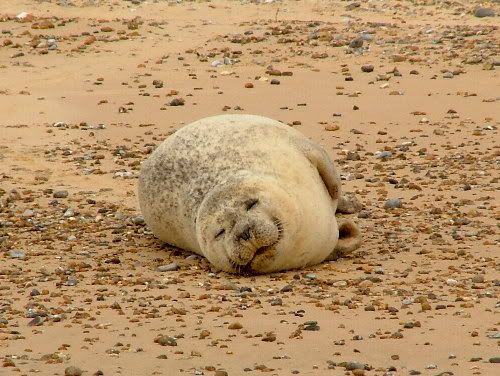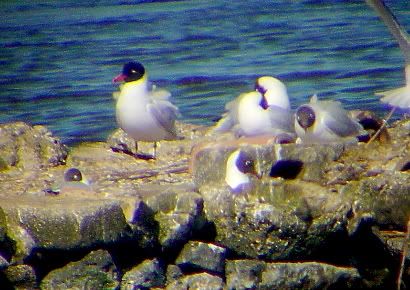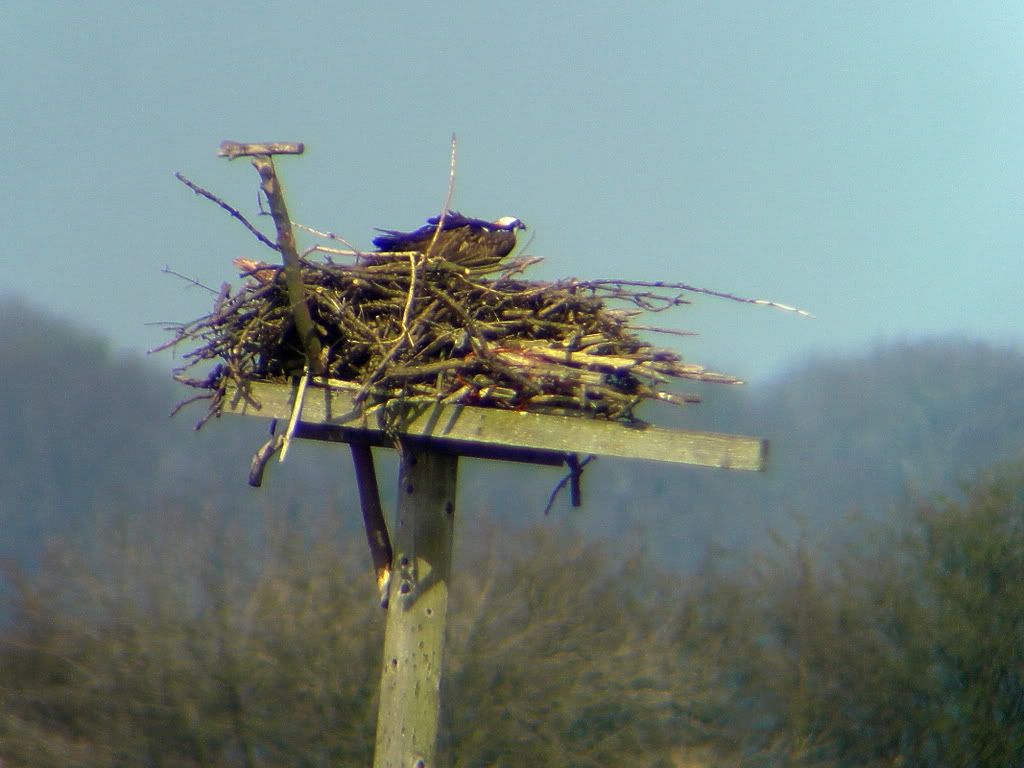Decent couple of birds when I passed through the park today, the Grasshopper Warbler showing well, fluffy white throat and all during its song, and speaking of white throats, yes, I thought recognised that chorus, the one that twitters away into nothing, a spirited Lesser Whitethroat (#109 on my carbon list).
Troubling couple of other observations this week too. After I reported the warblers and Whinchats to a couple of sightings websites there were suddenly birders around the place when I'd normally seldom see any at all. Worse, a couple thought nothing of clambering over the fenced off area into our best habitat that we're trying to protect until new bylaws can be passed.
Cannot understand folks who think nothing of trampling on land that clearly isn't meant to be accessed. They don't exactly give birders a very good name, you know?
In the national news, there's a new theory on why urban Robins sing at night. Apparently it's too noisy to bother in the daytime, so they save their efforts for the quiet of after dark.
Maybe it does make more sense that the old streetlights theory. However did we really believe birds couldn't tell the difference between night and day?
Thursday, 26 April 2007
Tuesday, 24 April 2007
Weekly Bird Count
Snuck out this afternoon to get around and make a bird count for the park. 37 species on a damp miserable day doesn't seem too bad, most notably 3 Grasshopper Warbler, 2 Whinchat, a couple more Blackcap, many Willow Warbler and Chiffchaff. Yes, the summer warblers are back.
One Grasshopper Warbler did show itself briefly and as ever looked surprisingly large with that big broad tail they have. I should expect the Whinchat [#143] will perform their usual routine of hanging around for two weeks and then disappearing.
One Grasshopper Warbler did show itself briefly and as ever looked surprisingly large with that big broad tail they have. I should expect the Whinchat [#143] will perform their usual routine of hanging around for two weeks and then disappearing.
Labels:
birding,
Brierley Forest Park,
Grasshopper Warbler
Saturday, 21 April 2007
Close Encounters of the Bird Kind
Haven't I used that pun before? Anyway...
Trying to get around the birdmiles limit I tagged along on my girlfriend's journey to work yesterday and had her drop me off at Carsington Reservoir. With few buses making it that far out into rural Derbyshire it meant I was there for the 10 hours until she could pick me up again. Plenty of time to squeeze out every last bird around. Redshank was a nice start, this one wandering a yard in front of the glass screen at the Wildlife Centre, completely oblivious to the thrilled onlookers inside.
Redshank was a nice start, this one wandering a yard in front of the glass screen at the Wildlife Centre, completely oblivious to the thrilled onlookers inside.
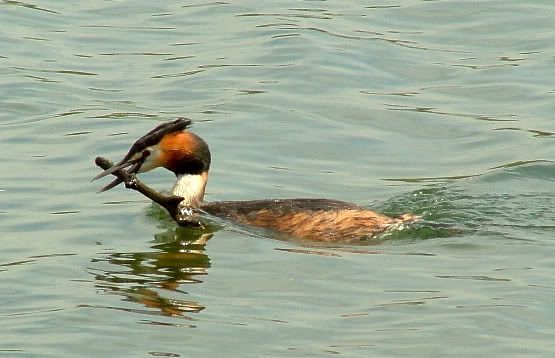 Almost as close were the nest-building Great Crested Grebe. A really nice touch for what is basically an education centre for local kids.
Almost as close were the nest-building Great Crested Grebe. A really nice touch for what is basically an education centre for local kids.
 Another nidifying pair were Oystercatcher, again close views, this time ten yards from a bird hide at the other end of the water.
Another nidifying pair were Oystercatcher, again close views, this time ten yards from a bird hide at the other end of the water.

Trying to get around the birdmiles limit I tagged along on my girlfriend's journey to work yesterday and had her drop me off at Carsington Reservoir. With few buses making it that far out into rural Derbyshire it meant I was there for the 10 hours until she could pick me up again. Plenty of time to squeeze out every last bird around.
 Redshank was a nice start, this one wandering a yard in front of the glass screen at the Wildlife Centre, completely oblivious to the thrilled onlookers inside.
Redshank was a nice start, this one wandering a yard in front of the glass screen at the Wildlife Centre, completely oblivious to the thrilled onlookers inside. Almost as close were the nest-building Great Crested Grebe. A really nice touch for what is basically an education centre for local kids.
Almost as close were the nest-building Great Crested Grebe. A really nice touch for what is basically an education centre for local kids. Another nidifying pair were Oystercatcher, again close views, this time ten yards from a bird hide at the other end of the water.
Another nidifying pair were Oystercatcher, again close views, this time ten yards from a bird hide at the other end of the water.
The feeding station outside that hide was fruitful for the day list, Blue Tit, Great Tit, Marsh Tit, etc
Several more thumbnails...
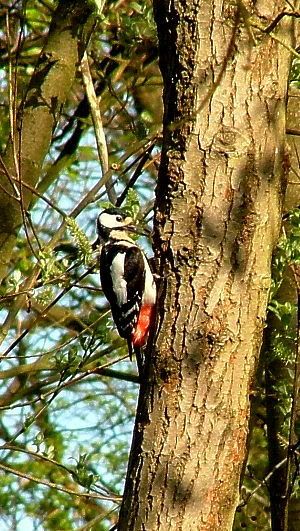
...and Great Spotted Woodpecker.
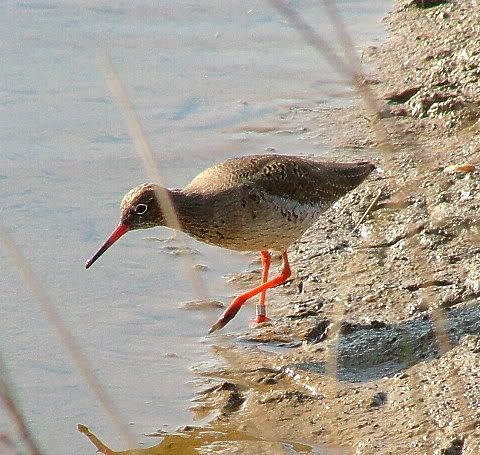 That ring, could this be the same ringed bird I saw in January? Very likely.
That ring, could this be the same ringed bird I saw in January? Very likely.

Most species are now in fine plumage, including the richly coloured Dabchicks. They were incessantly vocal too, still divying up territory it seemed.
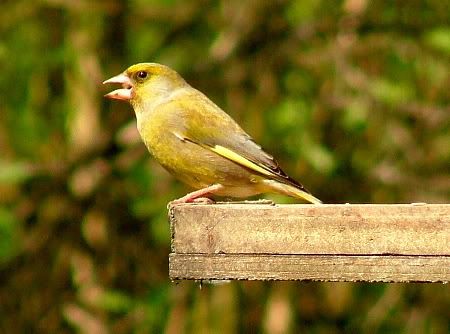
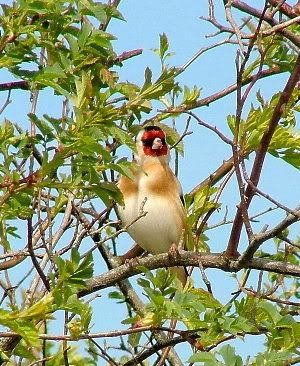
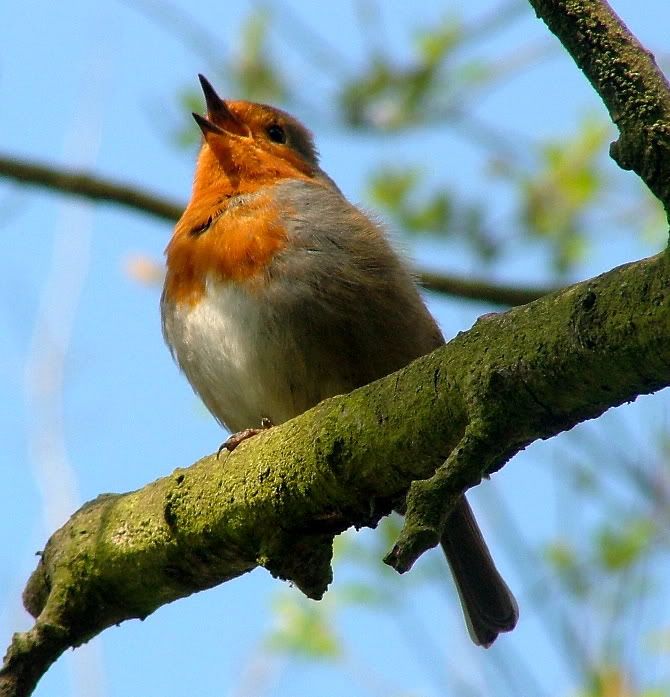
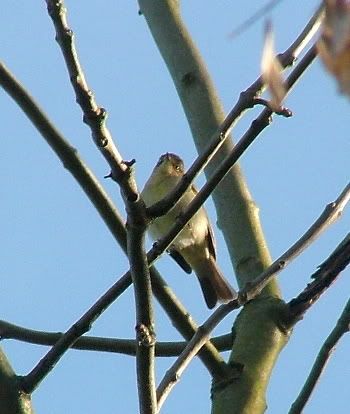
Several more thumbnails...

...and Great Spotted Woodpecker.
 That ring, could this be the same ringed bird I saw in January? Very likely.
That ring, could this be the same ringed bird I saw in January? Very likely.
Most species are now in fine plumage, including the richly coloured Dabchicks. They were incessantly vocal too, still divying up territory it seemed.




Chiffchaff were another constant theme.
My day total came out at 64 species after a brief detour to Ogston Reservoir on the way home, where late on I saw my first Common Sandpiper (indeed first Sandpiper) of the year (#141), and big numbers of Sand Martin.
Birds of the day? The Great Northern Diver is still at Carsington, at least one has been there all the way back to late November. A nesting pair of Raven displayed in the blue skies, and in one of the carparks a pristine male Lesser Whitethroat was twittering its fine song. Waders were a bit sparse, only a couple of Little Ringed Plover really to speak of, and all of the winter ducks have left now. The three resident hirudine were plentiful, only a few House Martin up there though. Right at the end, to top of my list a splendid Yellow Wagtail appeared, do they ever not dazzle?
Oh and in one of the ponds I saw Palmate Newt, which always look rather alien to me.
At the Wildlife Centre I was closely followed in by a group of school children. Sitting in there with all my gear obviously sparked the curiosity of one of the boys who sat beside me and began quizzing me about birding. He must have been perhaps 8 or 9 years of age. He asked why do I like birdwatching, and of all the possible answers I could give I decided to explain the challenge of looking for rare and interesting species. That seemed to register well with the kid and he drew his own comparison to fishing.
Thinking further he then unleashed his killer question, "So... what's a duck worth?"
Mercifully his teacher called him away, to my utter relief because I really had no idea how to answer him.
I mean, what do you suppose your answer would be?
Some of the other kids asked about my scope and the ducks, and generally I was really chuffed they were asking questions about our hobby. Frankly, for all of the birds I saw, it was the coolest part of my day.
My day total came out at 64 species after a brief detour to Ogston Reservoir on the way home, where late on I saw my first Common Sandpiper (indeed first Sandpiper) of the year (#141), and big numbers of Sand Martin.
Birds of the day? The Great Northern Diver is still at Carsington, at least one has been there all the way back to late November. A nesting pair of Raven displayed in the blue skies, and in one of the carparks a pristine male Lesser Whitethroat was twittering its fine song. Waders were a bit sparse, only a couple of Little Ringed Plover really to speak of, and all of the winter ducks have left now. The three resident hirudine were plentiful, only a few House Martin up there though. Right at the end, to top of my list a splendid Yellow Wagtail appeared, do they ever not dazzle?
Oh and in one of the ponds I saw Palmate Newt, which always look rather alien to me.
At the Wildlife Centre I was closely followed in by a group of school children. Sitting in there with all my gear obviously sparked the curiosity of one of the boys who sat beside me and began quizzing me about birding. He must have been perhaps 8 or 9 years of age. He asked why do I like birdwatching, and of all the possible answers I could give I decided to explain the challenge of looking for rare and interesting species. That seemed to register well with the kid and he drew his own comparison to fishing.
Thinking further he then unleashed his killer question, "So... what's a duck worth?"
Mercifully his teacher called him away, to my utter relief because I really had no idea how to answer him.
I mean, what do you suppose your answer would be?
Some of the other kids asked about my scope and the ducks, and generally I was really chuffed they were asking questions about our hobby. Frankly, for all of the birds I saw, it was the coolest part of my day.
Labels:
birding,
carsington,
Derbyshire,
grebe,
oystercatcher,
redshank,
robin
Tuesday, 17 April 2007
It paid to go late
Poor video even by my standards, what's on there are Little Gull.
Last evening was pleasant enough to go look for the bats again, and that we did. However from the platform we saw half a dozen small gulls circling in the gloom just after sunset. Interesting first of all because practically all of the gulls have now left, in fact I couldn't see any others. Secondly their flight was swift and bouncy, tern-like, and on the wing they snatched morsels from the surface of the water just like terns do. Finally, the dark underwing was confirmation, they were Little Gull.
They did laps of the reservoir for about half an hour and then as the very last light was fading they rose higher in the sky and headed off east. One of my best ever local ticks.
Video - Very Distant Little Gull
Last evening was pleasant enough to go look for the bats again, and that we did. However from the platform we saw half a dozen small gulls circling in the gloom just after sunset. Interesting first of all because practically all of the gulls have now left, in fact I couldn't see any others. Secondly their flight was swift and bouncy, tern-like, and on the wing they snatched morsels from the surface of the water just like terns do. Finally, the dark underwing was confirmation, they were Little Gull.
They did laps of the reservoir for about half an hour and then as the very last light was fading they rose higher in the sky and headed off east. One of my best ever local ticks.
Video - Very Distant Little Gull
Labels:
birding,
birds,
kings mill reservoir,
little gull,
Nottinghamshire
Monday, 16 April 2007
Red-throated Diver (rather on the white side)
With all those bird-miles burnt up on the way to Norfolk we're having to keep our weekend forrays closer afield for the remainder of the month. Fortunately a nearby opportunity for a lifer was there for the taking. First reports of this Red-throated Diver on a lake near Clumber Park came in two weeks ago, so it's become bit of a stayer, best bird in the county for a while too, and #191 for my life list. Don't get many of them this far inland in England.
 The Diver was a real beauty, showing very well for the hour we spent there. To the eye it looked a very elegant bird, moreso than a camera could capture, and those eyes, black-eyes, like shark eyes, seemed to give the bird even more character.
The Diver was a real beauty, showing very well for the hour we spent there. To the eye it looked a very elegant bird, moreso than a camera could capture, and those eyes, black-eyes, like shark eyes, seemed to give the bird even more character.
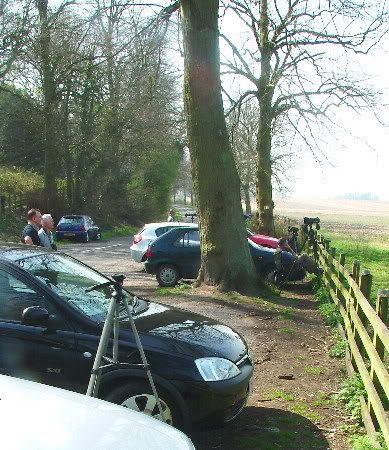
Plenty came to see it. This pull-in is a well-known local raptor watchpoint, formerly famous for Honey Buzzard. Not sure they are seen so often these days though, possibly discouraged by the recent explosion in Common Buzzard numbers which have already made Heron so nervous they've abandoned a nearby colony.
A few thumbnails of the day's other birds...
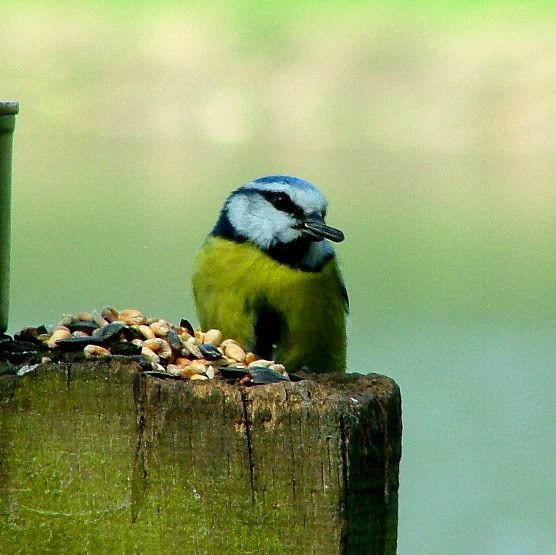
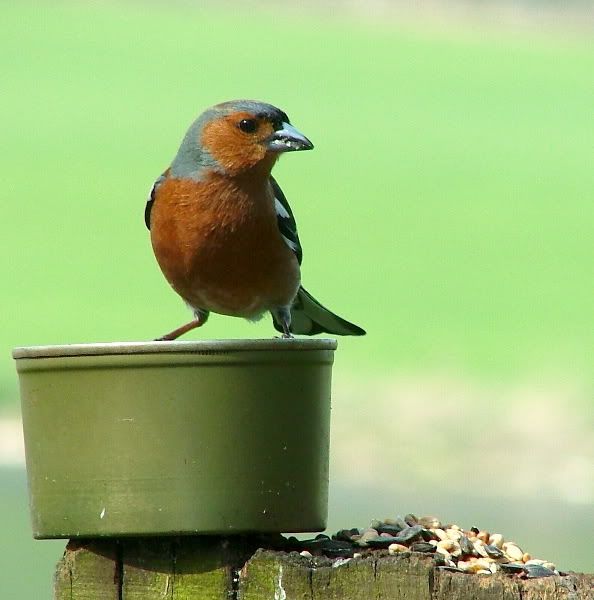
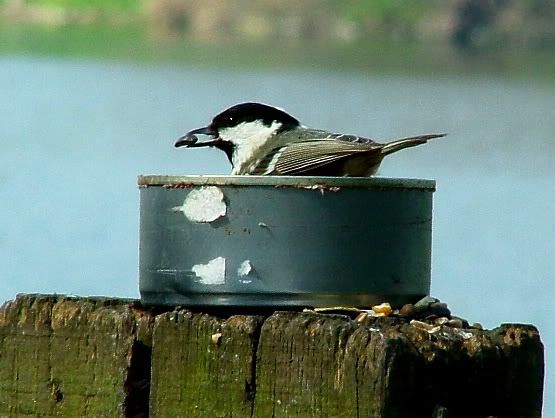

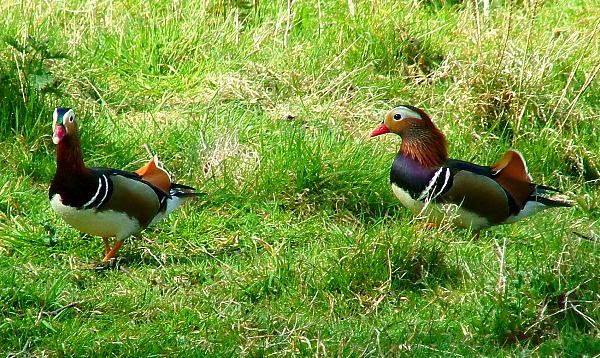 Small numbers of Mandarin hang around the feeding station, probably a nascient 'wild' population ready to grow rather than escape
Small numbers of Mandarin hang around the feeding station, probably a nascient 'wild' population ready to grow rather than escape
And finally...
Video - Red-throated Diver
 The Diver was a real beauty, showing very well for the hour we spent there. To the eye it looked a very elegant bird, moreso than a camera could capture, and those eyes, black-eyes, like shark eyes, seemed to give the bird even more character.
The Diver was a real beauty, showing very well for the hour we spent there. To the eye it looked a very elegant bird, moreso than a camera could capture, and those eyes, black-eyes, like shark eyes, seemed to give the bird even more character.
Plenty came to see it. This pull-in is a well-known local raptor watchpoint, formerly famous for Honey Buzzard. Not sure they are seen so often these days though, possibly discouraged by the recent explosion in Common Buzzard numbers which have already made Heron so nervous they've abandoned a nearby colony.
A few thumbnails of the day's other birds...




 Small numbers of Mandarin hang around the feeding station, probably a nascient 'wild' population ready to grow rather than escape
Small numbers of Mandarin hang around the feeding station, probably a nascient 'wild' population ready to grow rather than escapeAnd finally...
Video - Red-throated Diver
Sunday, 15 April 2007
Norfolk Trip Part Six: Holkham and Home

Tuesday had come and the long journey home beckoned. There was just enough time to cram in Holkham NNR, where I could get in a little birding and she could enjoy the beach. From the one hide I visited there was a wide open view across the marshland, out there were plenty more Greylag, a two pairs of Pintails, more Black-tailed Godwit, Lapwing etc. In the hide a couple of the locals were excited by a Ruddy Duck, honestly they could have ours from Notts if they want them. A few Avocet poked around the marsh too, and in the distance a handful of Little Egret flew by.
Without doubt the best bird might almost have been dismissed as yet another distant Egret flying across, made sense to check though when I observed the outstretched neck and broad bill. It was a Spoonbill!
After alerting the rest of the hide one of the local birders told me an individual Spoonbill had been seen on and off for a while now, and generally hung around the Heronry out to the west where it made rudimentary efforts at building a nest. Also several pairs of Egret up there I was told.
Out on the beach meanwhile the passage of Swallows grew throughout the day.

Back into the car and half-way home we stopped at Milton Country Park for the last half hour of daylight. It was here we saw three woodland species, Blackcap, Greater Spotted and Green Woodpecker that brought the species count for the trip up to an even 100.
Unspoken target achieved, just.
So that was our big Norfolk trip, the county really is as good for birds as all the guides say.
Labels:
birdwatching,
Cambridge,
Holkham,
Milton,
Norfolk
Saturday, 14 April 2007
Norfolk Trip Part Five: Cley Marshes
It was time to expand a little, do something away from the bird reserves. In the flat were several leaflets for various boat trips around Norfolk and two of them stood out, a 'seal trip' up to Blakeney Point and an excursion onto the Broads out from Wroxham. Quickly we called around and discovered there would be room on the last boats of the day if only we could manage the 45 minute drive between the two quays without delay and direct through those small maze-like Norfolk farm roads. Somehow we accomplished it.
Among them were the occasional round-head Common Seal, only a few though.
 So far as the birds went it was much the same as before, Oystercatcher, Redshank, Black-tailed Godwit for the waders, Brent Geese were scattered here and there. Bird of the day were the first Sandwich Terns, among the hundreds of Black-headed Gull there can't have been more than half a dozen that we could see.
So far as the birds went it was much the same as before, Oystercatcher, Redshank, Black-tailed Godwit for the waders, Brent Geese were scattered here and there. Bird of the day were the first Sandwich Terns, among the hundreds of Black-headed Gull there can't have been more than half a dozen that we could see.
 And then the hurried journey down to the Broads tour. Birds were quite few here. I carried slim hopes of seeing the Norfolk Cranes flying over, it wasn't to be though.
And then the hurried journey down to the Broads tour. Birds were quite few here. I carried slim hopes of seeing the Norfolk Cranes flying over, it wasn't to be though.
 What we got were nice views of familiar birds, Heron, Coot, Great Crested Grebe, etc. Our captain told us there were far fewer than a month before. Apparently it was chock-a-block with spectacular numbers of wintering Coot.
What we got were nice views of familiar birds, Heron, Coot, Great Crested Grebe, etc. Our captain told us there were far fewer than a month before. Apparently it was chock-a-block with spectacular numbers of wintering Coot.
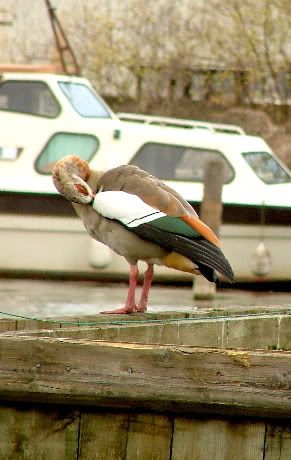 The most notable species was the Egyptian Goose. Plenty of them around, much to the consternation of the (very rich) inhabitants on the Broads. The geese wreck the thatched roofs found on their properties, pulling them to pieces and sometimes nesting ontop unless carefully protected against.
The most notable species was the Egyptian Goose. Plenty of them around, much to the consternation of the (very rich) inhabitants on the Broads. The geese wreck the thatched roofs found on their properties, pulling them to pieces and sometimes nesting ontop unless carefully protected against.
 So far as the birds went it was much the same as before, Oystercatcher, Redshank, Black-tailed Godwit for the waders, Brent Geese were scattered here and there. Bird of the day were the first Sandwich Terns, among the hundreds of Black-headed Gull there can't have been more than half a dozen that we could see.
So far as the birds went it was much the same as before, Oystercatcher, Redshank, Black-tailed Godwit for the waders, Brent Geese were scattered here and there. Bird of the day were the first Sandwich Terns, among the hundreds of Black-headed Gull there can't have been more than half a dozen that we could see. And then the hurried journey down to the Broads tour. Birds were quite few here. I carried slim hopes of seeing the Norfolk Cranes flying over, it wasn't to be though.
And then the hurried journey down to the Broads tour. Birds were quite few here. I carried slim hopes of seeing the Norfolk Cranes flying over, it wasn't to be though. What we got were nice views of familiar birds, Heron, Coot, Great Crested Grebe, etc. Our captain told us there were far fewer than a month before. Apparently it was chock-a-block with spectacular numbers of wintering Coot.
What we got were nice views of familiar birds, Heron, Coot, Great Crested Grebe, etc. Our captain told us there were far fewer than a month before. Apparently it was chock-a-block with spectacular numbers of wintering Coot. The most notable species was the Egyptian Goose. Plenty of them around, much to the consternation of the (very rich) inhabitants on the Broads. The geese wreck the thatched roofs found on their properties, pulling them to pieces and sometimes nesting ontop unless carefully protected against.
The most notable species was the Egyptian Goose. Plenty of them around, much to the consternation of the (very rich) inhabitants on the Broads. The geese wreck the thatched roofs found on their properties, pulling them to pieces and sometimes nesting ontop unless carefully protected against.Finally that day on the journey back north along the coast we dotted the villages, stopping for a walk at Winterton Dunes.
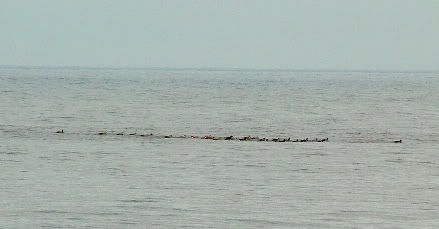 Just off shore a raft of 50 or so Common Scoter bobbed in and out of view, frequently disappearing as they dived en masse.
Just off shore a raft of 50 or so Common Scoter bobbed in and out of view, frequently disappearing as they dived en masse.
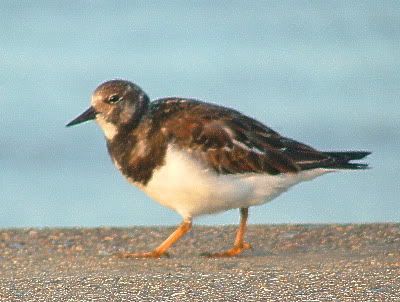 One more surprise awaited us very late in the day. Passing through the tiny coastal hamlet of Walcott we saw birds running and pecking along the top of the cement sea defense beside the road. Pulling over we realised they were Turnstone, still largely in winter costume and barely more than a metre away from the car window.
One more surprise awaited us very late in the day. Passing through the tiny coastal hamlet of Walcott we saw birds running and pecking along the top of the cement sea defense beside the road. Pulling over we realised they were Turnstone, still largely in winter costume and barely more than a metre away from the car window.
 Just off shore a raft of 50 or so Common Scoter bobbed in and out of view, frequently disappearing as they dived en masse.
Just off shore a raft of 50 or so Common Scoter bobbed in and out of view, frequently disappearing as they dived en masse. One more surprise awaited us very late in the day. Passing through the tiny coastal hamlet of Walcott we saw birds running and pecking along the top of the cement sea defense beside the road. Pulling over we realised they were Turnstone, still largely in winter costume and barely more than a metre away from the car window.
One more surprise awaited us very late in the day. Passing through the tiny coastal hamlet of Walcott we saw birds running and pecking along the top of the cement sea defense beside the road. Pulling over we realised they were Turnstone, still largely in winter costume and barely more than a metre away from the car window.Video - Turnstone on the sea wall
By now Norfolk seemed to be unfailingly wonderful for birds, even on the quiet days.
By now Norfolk seemed to be unfailingly wonderful for birds, even on the quiet days.
Labels:
birding,
birdwatching,
broads,
Norfolk,
seals. turnstone
Bat-tastic
Took a late walk to reservoir this week and found a real treat. On the viewing platform between the trees, overlooking the water, just after sunset bats emerge, hundreds of them!
Although the videos are rather on the dark side you can sort of get an idea of what it's like, even so there must have been four or five times more than my dinky little camera capture.
I'm assuming most were Pipistrelle, both on size and the way they didn't hunt especially close to the water surface - like a Daubenton's probably would. High up flew really quite large bats, which often seemed to swoop rather than flutter. These I'm even less sure about on the ID, possibly Noctule since they look so big and kept high. At best, not being much of a bat expert, I'm still guessing.
Video 1 - Kings Mill bats
Video 2 - Kings Mill bats
Video 3 - Kings Mill bats, a big one!
All of this sits next to a very busy dual carriageway, one of the main roads into Mansfield, I couldn't have imagined it.
Although the videos are rather on the dark side you can sort of get an idea of what it's like, even so there must have been four or five times more than my dinky little camera capture.
I'm assuming most were Pipistrelle, both on size and the way they didn't hunt especially close to the water surface - like a Daubenton's probably would. High up flew really quite large bats, which often seemed to swoop rather than flutter. These I'm even less sure about on the ID, possibly Noctule since they look so big and kept high. At best, not being much of a bat expert, I'm still guessing.
Video 1 - Kings Mill bats
Video 2 - Kings Mill bats
Video 3 - Kings Mill bats, a big one!
All of this sits next to a very busy dual carriageway, one of the main roads into Mansfield, I couldn't have imagined it.
Labels:
bats,
birding,
kings mill reservoir,
Nottinghamshire
Friday, 13 April 2007
Norfolk Trip Part Four: Cley Marshes
Onto the Sunday, we were staying in a holiday flat just west of Sheringham, less than ten miles away from NWT Cley Marshes, so it was there I was dropped off while my SO went shopping.
The reserve has a futuristic looking new visitor centre, so futuristic in fact that it isn't yet open. Same goes for some of the paths and one of the hides, something I wish the chap taking my entrance fee had told me. It really is pretty dismaying to trudge half a mile or more along a shingle bank to find a hide marked on the map is only half constructed and well cordoned off.
Otherwise it was a pretty good day.
 Again the Avocet, Oystercatcher, Black-tailed Godwit, Redshank, Ruff, Curlew, Lapwing and Golden Plover, were around. In the lagoon to the east of the reserve were a few Dunlin and Ringed Plover.
Again the Avocet, Oystercatcher, Black-tailed Godwit, Redshank, Ruff, Curlew, Lapwing and Golden Plover, were around. In the lagoon to the east of the reserve were a few Dunlin and Ringed Plover. With the Greylag were three Pink-feet feeding in the grass beside one of the lagoons, and late on a flock of 23 flew over. Funny I swear I could remember reading they'd all left for the north well over two months ago.
With the Greylag were three Pink-feet feeding in the grass beside one of the lagoons, and late on a flock of 23 flew over. Funny I swear I could remember reading they'd all left for the north well over two months ago.
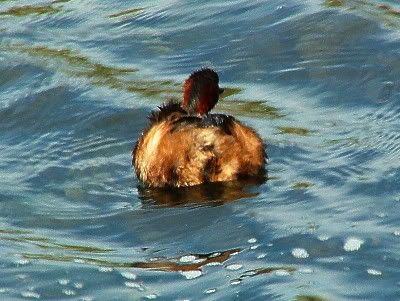 Feather duster-bottomed Dabchicks were plentiful in the ditch beside the road.
Feather duster-bottomed Dabchicks were plentiful in the ditch beside the road.
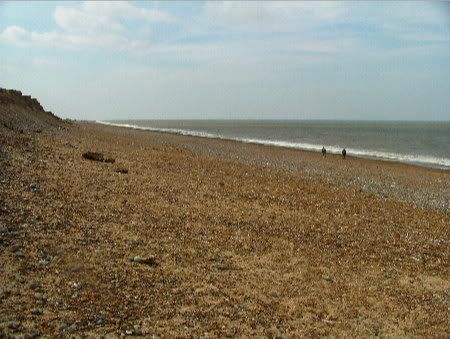 Half way around I reached the shingle sea wall and over it spread a wide sandy beach popular with tourists. I decided to sit, eat my lunch and watch the sea for a while, only saw the ordinary gulls though.
Half way around I reached the shingle sea wall and over it spread a wide sandy beach popular with tourists. I decided to sit, eat my lunch and watch the sea for a while, only saw the ordinary gulls though.
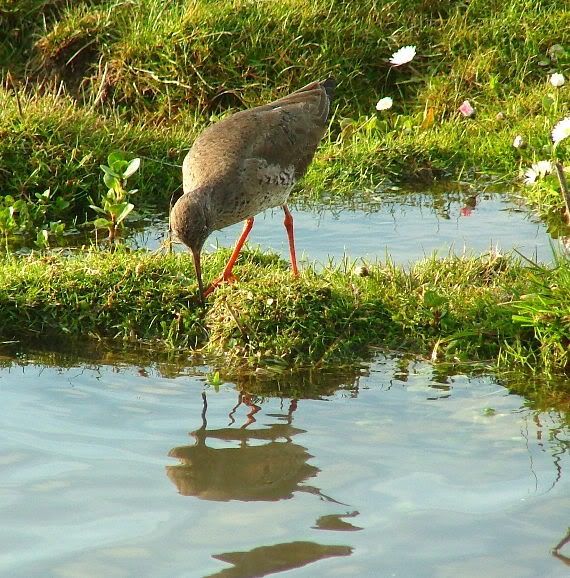 From one hide in particular, the one apart from the three that sit side-by-side, I got wonderfully close views of Redshank...
From one hide in particular, the one apart from the three that sit side-by-side, I got wonderfully close views of Redshank...
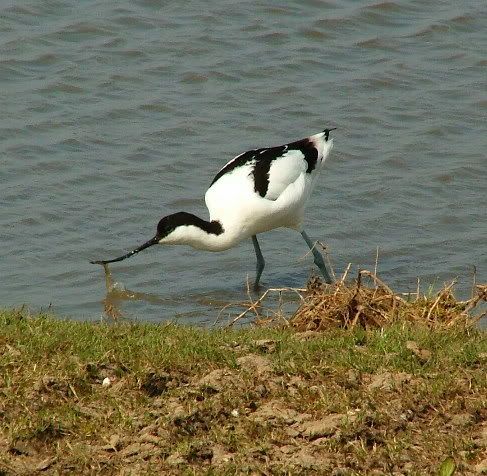 ...and Avocet.
...and Avocet.
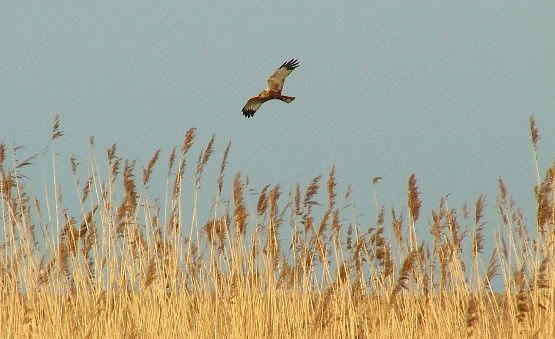 In the sky all day sailed the Marsh Harriers, two females and a male it seemed, which is about the average bigamous ratio for these raptors.
In the sky all day sailed the Marsh Harriers, two females and a male it seemed, which is about the average bigamous ratio for these raptors.
The reserve has a futuristic looking new visitor centre, so futuristic in fact that it isn't yet open. Same goes for some of the paths and one of the hides, something I wish the chap taking my entrance fee had told me. It really is pretty dismaying to trudge half a mile or more along a shingle bank to find a hide marked on the map is only half constructed and well cordoned off.
Otherwise it was a pretty good day.
 Again the Avocet, Oystercatcher, Black-tailed Godwit, Redshank, Ruff, Curlew, Lapwing and Golden Plover, were around. In the lagoon to the east of the reserve were a few Dunlin and Ringed Plover.
Again the Avocet, Oystercatcher, Black-tailed Godwit, Redshank, Ruff, Curlew, Lapwing and Golden Plover, were around. In the lagoon to the east of the reserve were a few Dunlin and Ringed Plover. With the Greylag were three Pink-feet feeding in the grass beside one of the lagoons, and late on a flock of 23 flew over. Funny I swear I could remember reading they'd all left for the north well over two months ago.
With the Greylag were three Pink-feet feeding in the grass beside one of the lagoons, and late on a flock of 23 flew over. Funny I swear I could remember reading they'd all left for the north well over two months ago. Feather duster-bottomed Dabchicks were plentiful in the ditch beside the road.
Feather duster-bottomed Dabchicks were plentiful in the ditch beside the road. Half way around I reached the shingle sea wall and over it spread a wide sandy beach popular with tourists. I decided to sit, eat my lunch and watch the sea for a while, only saw the ordinary gulls though.
Half way around I reached the shingle sea wall and over it spread a wide sandy beach popular with tourists. I decided to sit, eat my lunch and watch the sea for a while, only saw the ordinary gulls though. From one hide in particular, the one apart from the three that sit side-by-side, I got wonderfully close views of Redshank...
From one hide in particular, the one apart from the three that sit side-by-side, I got wonderfully close views of Redshank... ...and Avocet.
...and Avocet. In the sky all day sailed the Marsh Harriers, two females and a male it seemed, which is about the average bigamous ratio for these raptors.
In the sky all day sailed the Marsh Harriers, two females and a male it seemed, which is about the average bigamous ratio for these raptors.If my visit was anything to go by Cley Marshes was very good, if not quite up the high standards of Snettisham and Titchwell, just on the basis of the bird-life around. Maybe when that visitor centre opens it'll nudge itself up a few more points.
ETA: Forgot to mention the Cetti's Warbler, I was told they were around but found nothing of them until very late in the day when I heard one calling. As is commonly the way with Cetti's, heard and not seen.
ETA: Forgot to mention the Cetti's Warbler, I was told they were around but found nothing of them until very late in the day when I heard one calling. As is commonly the way with Cetti's, heard and not seen.
Norfolk Trip Part Three: Titchwell
...and on to Titchwell Marsh RSPB.

By now it was around 5pm with the late-in-the-day shadows getting long so we imagined the reserve might be fairly quiet. Boy were we wrong! There must have been well over a hundred people walking around the reserve, many of them seemed to be non-birders just going for an evening stroll. Pretty nice spot for it too. Plenty of birdsong, particularly Chiffchaff in the wooded area.
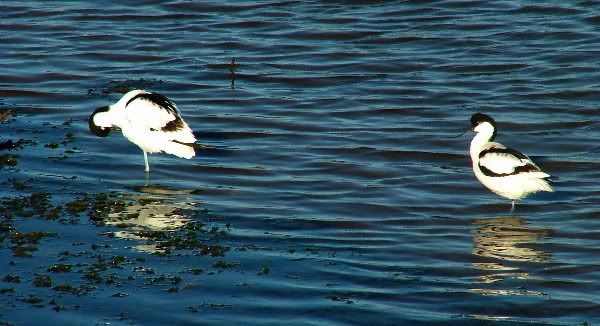 Here the Avocet numbered upwards of 200 and they were very confiding, little more than 10 yards in front of the hide. You could watch every detail on them, no need for bins. Out across the marsh were Black-tailed Godwit, Ruff, Curlew, the odd Golden Plover too, and regular ducks.
Here the Avocet numbered upwards of 200 and they were very confiding, little more than 10 yards in front of the hide. You could watch every detail on them, no need for bins. Out across the marsh were Black-tailed Godwit, Ruff, Curlew, the odd Golden Plover too, and regular ducks.
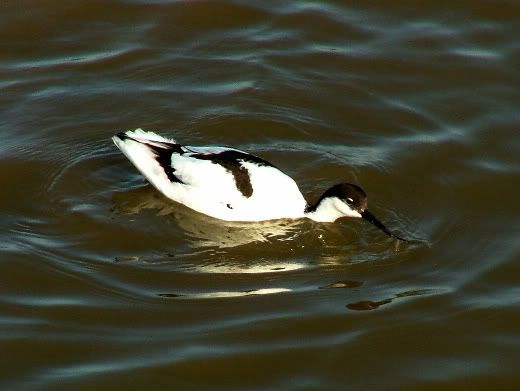 This photograph was taken from the path leading to the sea wall, the Avocet upending like a duck on your local pond and just as close.
This photograph was taken from the path leading to the sea wall, the Avocet upending like a duck on your local pond and just as close.
As we walked further on a single Little Egret flew by. They're around in the region, if still not yet in very big numbers, and at this time at least six Marsh Harrier descended into the roost.
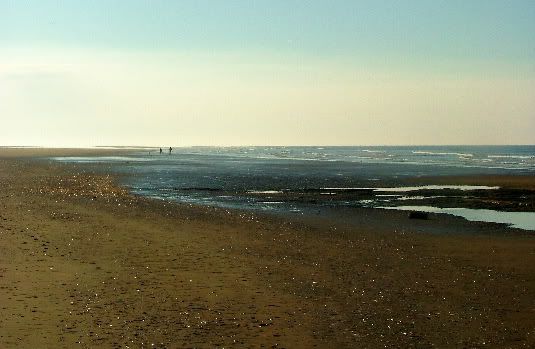
Down onto the beach and the sea was half-in. In among the shallow rock pools Turnstone busily pecked, above Oystercatcher circled in a small flock, and westwards 20 or so Sanderling ran around in between the surf.
All in all very memorable, the Snettisham-Titchwell double looks to be a natural choice if you're in the region. I can't see anybody leaving disappointed.

By now it was around 5pm with the late-in-the-day shadows getting long so we imagined the reserve might be fairly quiet. Boy were we wrong! There must have been well over a hundred people walking around the reserve, many of them seemed to be non-birders just going for an evening stroll. Pretty nice spot for it too. Plenty of birdsong, particularly Chiffchaff in the wooded area.
 Here the Avocet numbered upwards of 200 and they were very confiding, little more than 10 yards in front of the hide. You could watch every detail on them, no need for bins. Out across the marsh were Black-tailed Godwit, Ruff, Curlew, the odd Golden Plover too, and regular ducks.
Here the Avocet numbered upwards of 200 and they were very confiding, little more than 10 yards in front of the hide. You could watch every detail on them, no need for bins. Out across the marsh were Black-tailed Godwit, Ruff, Curlew, the odd Golden Plover too, and regular ducks. This photograph was taken from the path leading to the sea wall, the Avocet upending like a duck on your local pond and just as close.
This photograph was taken from the path leading to the sea wall, the Avocet upending like a duck on your local pond and just as close.
Down onto the beach and the sea was half-in. In among the shallow rock pools Turnstone busily pecked, above Oystercatcher circled in a small flock, and westwards 20 or so Sanderling ran around in between the surf.
All in all very memorable, the Snettisham-Titchwell double looks to be a natural choice if you're in the region. I can't see anybody leaving disappointed.
Thursday, 12 April 2007
Yellowheads
Relieved of baby-sitting duties I whipped down on the bike to the pit hoping I might get part of the Ring Ouzel influx that's begun, the pit being the best local spot for passages. Checked every Blackbird and no luck so far as that bird goes, still got a decent bird, my first Yellow Wagtail of the year (#135), a pair in fact. To go with the two Ringed Plover and two Redshank.
Labels:
birdwatching,
Derbyshire,
Nottinghamshire,
Yellow Wagtail,
Yellowhammer
Norfolk Trip Part Two: Snettisham
So onwards from Rutland, we spent the second day dotting up the north Norfolk coast to the RSPB reserves at Snettisham and Titchwell. Always heard big things about both places, had not yet been though. The truth? They're up to their billing.
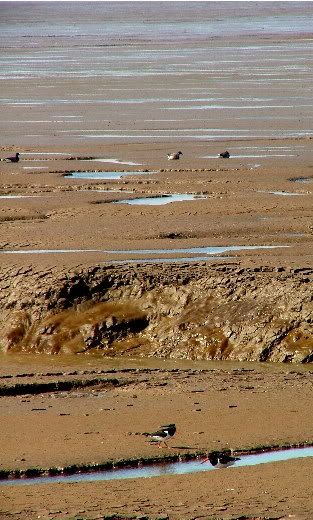
Although the tide was a long way out the mudflats at Snettisham still proved fruitful, sitting on the sea wall we could see among others, crowds of Curlew, Grey and Golden Plover, Black-tailed Godwit, Avocet and Brent Geese stretching into the haze beyond the horizon.
The walk from the car park is pretty long compared to some reserves and that is no bad thing. Along the way we saw Skylark, Linnet, various Geese flying overhead. All of the hides look out onto a lagoon where Black-headed Gull and Avocet were preparing to breed. Geese were plentiful, Greylag, Brent, Canada, a couple of late Pink-feet, Barnacle and two Snow Geese with them. Lots of duck too though nothing special, the regular, Wigeon, Teal, Shoveler, Gadwall, etc.
 Bird of the day, Shore Lark, two pairs foraging along the strand line and up to the sea wall, just along from where we sat. That's #190 for me. Marvellous views too, all the detail on the facial mask and true yellow too.
Bird of the day, Shore Lark, two pairs foraging along the strand line and up to the sea wall, just along from where we sat. That's #190 for me. Marvellous views too, all the detail on the facial mask and true yellow too.

Although the tide was a long way out the mudflats at Snettisham still proved fruitful, sitting on the sea wall we could see among others, crowds of Curlew, Grey and Golden Plover, Black-tailed Godwit, Avocet and Brent Geese stretching into the haze beyond the horizon.
The walk from the car park is pretty long compared to some reserves and that is no bad thing. Along the way we saw Skylark, Linnet, various Geese flying overhead. All of the hides look out onto a lagoon where Black-headed Gull and Avocet were preparing to breed. Geese were plentiful, Greylag, Brent, Canada, a couple of late Pink-feet, Barnacle and two Snow Geese with them. Lots of duck too though nothing special, the regular, Wigeon, Teal, Shoveler, Gadwall, etc.
With all those screeching Black-headed Gull around it seemed a good idea to check for Mediterranean Gull and it was worth it. There were at least two, with one bird showing very well. Initially I was a bit confused by the black dots on the wing-tips and eventually settled for calling it s a '2nd summer' bird.
 Bird of the day, Shore Lark, two pairs foraging along the strand line and up to the sea wall, just along from where we sat. That's #190 for me. Marvellous views too, all the detail on the facial mask and true yellow too.
Bird of the day, Shore Lark, two pairs foraging along the strand line and up to the sea wall, just along from where we sat. That's #190 for me. Marvellous views too, all the detail on the facial mask and true yellow too.Back toward the car park and a couple more species, Red-legged Partridge showing particularly well. And across the path scuttled a Sand Lizard, it was brilliantly green, like something out of a pet shop.
The only drawback we found were the lack of facilities at Snettisham, no visitor centre, no reception hide, no toilets, nothing really, except the car park and hides. I was quite surprised to find this at such a famous reserve. The only other word of warning is that during our time there Snettisham appeared popular with group visitors, the sort that stick together and occupy an entire hide instead of splitting up to allow space for others, so there wasn't much room to move in some of the hides.
Still, a top visit, and we must return one day for that high tide winter spectacular. It was pretty gratifying to loop the reserve closely behind a man and his young son. The kid looked genuinely enthused.
Then it was onwards for an evening at Titchwell, just ten miles along the A149, leaving behind the famed Black-eared Kite that hangs around the area. It's been a long stayer since November and throughout that time probably the 'best' bird in Britain, a real 'mega'. They apparently belong in China and this juvenile is still the only individual ever to be seen in Western Europe. Damned elusive too though, even for those on all the best rarities paging services.
Not imagining we would find it, I couldn't count myself disappointed when we didn't.
The only drawback we found were the lack of facilities at Snettisham, no visitor centre, no reception hide, no toilets, nothing really, except the car park and hides. I was quite surprised to find this at such a famous reserve. The only other word of warning is that during our time there Snettisham appeared popular with group visitors, the sort that stick together and occupy an entire hide instead of splitting up to allow space for others, so there wasn't much room to move in some of the hides.
Still, a top visit, and we must return one day for that high tide winter spectacular. It was pretty gratifying to loop the reserve closely behind a man and his young son. The kid looked genuinely enthused.
Then it was onwards for an evening at Titchwell, just ten miles along the A149, leaving behind the famed Black-eared Kite that hangs around the area. It's been a long stayer since November and throughout that time probably the 'best' bird in Britain, a real 'mega'. They apparently belong in China and this juvenile is still the only individual ever to be seen in Western Europe. Damned elusive too though, even for those on all the best rarities paging services.
Not imagining we would find it, I couldn't count myself disappointed when we didn't.
Wednesday, 11 April 2007
Norfolk Trip Part One: Via Rutland
Okay, a lot of updating to do here after our brief Easter sojourn in Norfolk, for the 4 days we managed spot on 100 species, a target I hadn't dared to speak of before totting up the list.
First stop on the way south was Rutland. The local news had mentioned the Osprey were returning so we hit the south side of the reservoir, the Lyndon Reserve where sightings are apparently most likely, it had just opened to the summer public that morning.
As we arrived there was quite the hubbub among the volunteers, they were very excited. Turned out a sixth bird had just returned, a female, and immediately rested into one of the next structures. We headed for the overlooking hides.
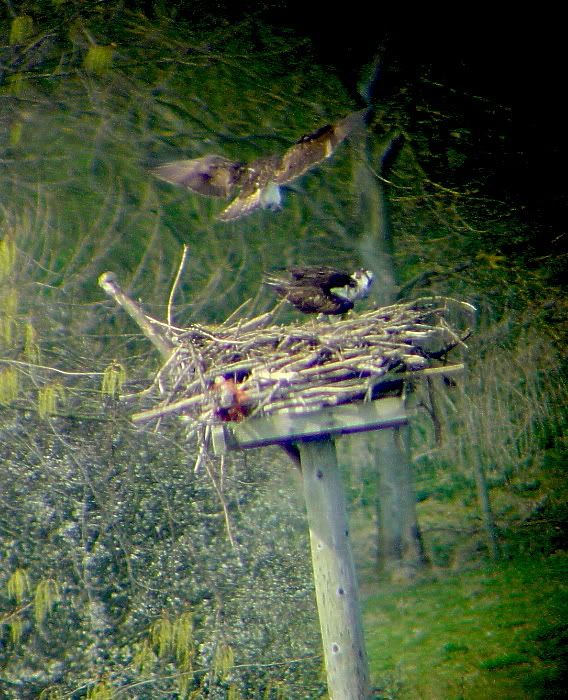
And he was ready to mate, little matter that she'd only just completed her migration all the way from Africa. Three times he mounted and three times she very certainly shrugged him off. So instead the male headed off to collect sticks and grass for the nest.
 That's him during his display flight (you can read more about this pair here).
That's him during his display flight (you can read more about this pair here).
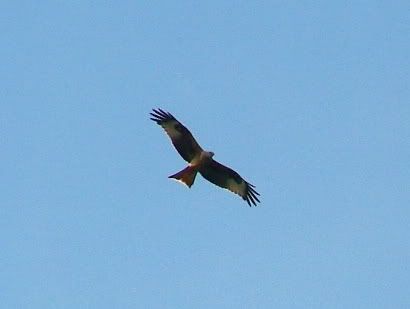 During which he was joined by a couple of Red Kite. Very special sights indeed.
During which he was joined by a couple of Red Kite. Very special sights indeed.
 And on the ground in front, two Muntjac nibbled on the reed edges.
And on the ground in front, two Muntjac nibbled on the reed edges.
First stop on the way south was Rutland. The local news had mentioned the Osprey were returning so we hit the south side of the reservoir, the Lyndon Reserve where sightings are apparently most likely, it had just opened to the summer public that morning.
As we arrived there was quite the hubbub among the volunteers, they were very excited. Turned out a sixth bird had just returned, a female, and immediately rested into one of the next structures. We headed for the overlooking hides.

And he was ready to mate, little matter that she'd only just completed her migration all the way from Africa. Three times he mounted and three times she very certainly shrugged him off. So instead the male headed off to collect sticks and grass for the nest.
 That's him during his display flight (you can read more about this pair here).
That's him during his display flight (you can read more about this pair here). During which he was joined by a couple of Red Kite. Very special sights indeed.
During which he was joined by a couple of Red Kite. Very special sights indeed. And on the ground in front, two Muntjac nibbled on the reed edges.
And on the ground in front, two Muntjac nibbled on the reed edges.In all honesty there wasn't very much else to be seen around the Lyndon Reserve so we headed for the Egleton side where habitat is a bit more varied, with wader scrapes etc. Even there it was pretty quiet, plenty of nice birds, Goldeneye, Pintail, Egyptian Goose, Chiffchaff, my first House Martin of the year, and the Tree Sparrow at the feeding station near the visitor centre.
It was a marvellous first leg to the trip.
It was a marvellous first leg to the trip.
Labels:
birdwatching,
digiscoping,
osprey,
red kite,
Rutland
Subscribe to:
Posts (Atom)

